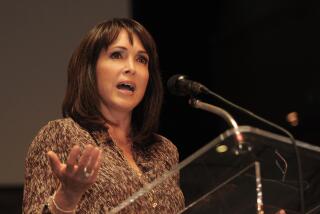Farewell dear slogans, thanks again
- Share via
For more than 40 years, news anchor Jerry Dunphy greeted his viewers with the words, “From the desert to the sea, to all of Southern California, a good evening.”
Longtime sportscaster Gil Stratton introduced his segments this way: “Time to call ‘em as I see ‘em.”
And veteran anchor George Putnam, a rival of Dunphy’s, would sign off his newscasts by announcing, “And that’s the up-to-the-minute news, up to the minute, that’s all the news.”
Stratton and Putnam died in the last two months, and Dunphy passed away in 2002. And for the most part, the era of signature phrases identified with television newscasters also has slipped away.
Why?
Nowadays newscasts “go right to the gut to try to grab and keep an audience -- ‘We’re live at [the] fire, car chase, killing,’ ” said Joe Saltzman, a USC journalism professor. “The news teases have replaced the signature lines because news audiences are dwindling and the [stations] are trying to get a younger audience. So they start each TV newscast with the best news footage they have.”
And it’s difficult for anchors to establish a trademark phrase when they’re not around long enough to put their stamp on one, said Dan Gingold, a former news producer.
Once, of course, network broadcasters were well-known for their artful sign-offs. The team of Chet Huntley and David Brinkley would end with “Good night, Chet” and “Good night, David.” Edward R. Murrow wished his listeners “Good night and good luck.” And Walter Cronkite would sum up the day’s events with his own signature send-off: “And that’s the way it is.”
On local TV, the gentlemanly Clete Roberts would sign off with “I thank you. I bid you good night.”
Now, in this more cynical time, the news anchor is often lampooned on screens big and small -- blowhard Ron Burgundy in the 2004 movie “Anchorman,” with his “Stay classy, San Diego” sign-off; smarmy Kent Brockman on TV’s “The Simpsons”; dim-witted Ted Baxter (“Good night and good news”) of “The Mary Tyler Moore Show.” Baxter was said to have been partially based on Putnam and Dunphy.
The roles of real-life anchors seem anything but colorful these days.
Consider the nondescript sign-off from newscasters at one of Los Angeles’ best-known local stations: “We know you have many choices for news. We thank you for choosing KCAL 9.”
Both Putnam and Stratton created their own trademark phrases. Stratton’s “Call ‘em as I see ‘em” referred to the fact that he was once a minor league baseball umpire. Putnam’s “All-the-news” declaration was meant to show that TV news was not shallow. Viewers had just heard all the news.
Dunphy did not create his own introduction. That was the work of producer Sam Zelman of KNXT-TV (now CBS2). The station was inaugurating “The Big News” in 1960, the nation’s first one-hour local newscast, and the lead-in was intended to show that “we were trying to reach a broad audience,” Zelman said.
Originally the intro was longer, beginning with “From Main Street to Malibu,” but it was trimmed so Dunphy wouldn’t have to utter such a mouthful. (With the current emphasis on glitz in television, the Malibu line might have been the last one cut today.)
Although Dunphy read his opening countless times over the years, it didn’t come automatically to him.
“If we didn’t write it into the prompter, he didn’t say it,” said Saltzman, a former writer at Channel 2. “I remember once I was writing the top of the news show and we all watched the news program in the newsroom. Dunphy came up and just started reading the news. The news director shouted, ‘Where the hell is from-the-desert-to-the-sea? Who wrote the . . . intro?’
“I sheepishly raised my hand and said, ‘I did,’ adding, ‘I didn’t know you actually have to write something he said every night,’ ” Saltzman recalled.
“The news director lashed into me and I almost lost my job.”
All agree that Dunphy was a great reader. He didn’t stumble at all, for instance, when the final words of his opening on one broadcast were changed because fires were raging across the Southland. “It is NOT a good evening,” he told viewers that night.
When Dunphy moved to KABC-TV Channel 7 in 1975, he took his standard intro with him.
“Those were informal days,” Zelman said. “Every thing didn’t go through a lawyer.”
And later, Dunphy packed up the intro again and took it to KCAL-TV Channel 9.
“Dunphy lived the role that was created for him,” said Pete Noyes, a former television news producer.
Indeed, Dunphy wrote several country songs, including one titled: “From the Desert to the Sea.”
--
steveharvey9@gmail.com


